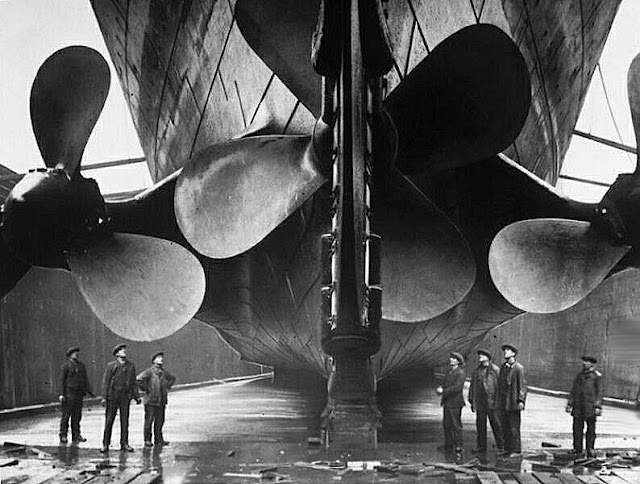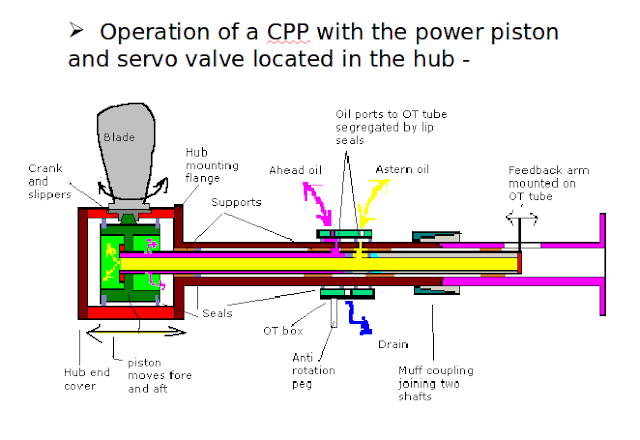Propeller can be defined as: A mechanical device formed by two or more blades that spin around a shaft and produces a propelling force by converting rotational motion into thrust. The ship propulsion system along with the main engine, Thrust block, Shaft, Stern Tube and propeller works on the third principle of Newtons law. Thrust is generated by the propeller which in turn pushes the ship in the Forward direction.
There can be Two,Three or One propeller fitted on the ship depending on the ships requirement for speed, cost, maintenance and maneuverability.
Material and construction
Ships propellers are made up of corrosion resistance material (Nikalium) having different elements in following proportion:
Copper - 80.2 %
Aluminum - 9.3 %
Nickel - 4.3 %
Iron - 4.0 %
Manganese - 1.2 %
Aluminum - 9.3 %
Nickel - 4.3 %
Iron - 4.0 %
Manganese - 1.2 %
Types of Propeller:
The type of propellant used must be chosen early in the design process of the ship as the type of propellant, even have a strong influence on the design of the ship. Most ship screws are fixed pitch fixed-propeller types. But there are various types of propeller that one can use:
- Fixed pitch propeller
- Detatchable blade propeller
- Controllable pitch propeller
- Voith Scneider propeller
- Azipod type propeller
- Kort nozzle propeller
Fixed pitch propeller: A fixed propeller is propeller with simpler models and used on merchant ships. These types of non-traditional feast Propeller is made from individual casting. They usually have an efficiency advantage, cost, and simplicity compared to other types of propellers.
 |
| Fixed Pitch Propeller |
Controllable pitch propeller: Propeller type in which the propeller thrust direction is controlled by changing the pitch of the propeller is known as CPP. It is used to control the speed and direction of the boat/ Ship without changing the speed or direction of the main shaft of the ship's propulsion.
Advantages:
- Where the operating conditions vary widely and maximum thrust is desired throughout these operating conditions, such as tug, trawler and offshore supply boat applications.
- Where shaft reversing capabilities are not readily provided by main engine (e.g. gas turbines).
- Where extensive low speed maneuvering is required for a diesel powered vessel.
- Where the ship will operate in ice-covered water. The unidirectional rotation of CPP subjects the Blades to less ice damage.
- When an improved maneuverability and a minimum ship stopping distance are desired. An infinitely variable thrust capability in either direction and a more rapid response to thrust reversal commands improve ship maneuverability and reduce the ship’s head reach.
- Where a constant shaft rpm is an advantage over wide range of operating powers.
Disadvantages :
- It is a complex system hence reduced reliability compared to fixed pitch.
- With oil in propeller boss, possibility of pollution of sea with oil.
- Increased maintenance on the propeller and extra maintenance because of additional equipments involved.
- Chances of propeller blades getting stuck at some particular pitch angle and thus giving no choice to vary the magnitude of the thrust.
Working of CPP
The pitch of the CPP blades is controlled hydraulically through a system consisting of a pump, piston, crosshead, and blade crank rings. The piston, crosshead, and crank rings are located in the propeller hub. High pressure hydraulic oil, acting on either side of the piston, moves the piston axially within the propeller hub.
The piston is attached to a piston rod that connects to the crosshead that moves axially with the piston. Sliding blocks fit in machined slots on the crosshead and these sliding blocks fit over eccentrically-located pins mounted on the crank pin rings. As the crosshead moves forward and backwards within the hub, the sliding blocks move in an arc that also moves the eccentric pin and rotates the crank pin rings to which the CPP
The piston is attached to a piston rod that connects to the crosshead that moves axially with the piston. Sliding blocks fit in machined slots on the crosshead and these sliding blocks fit over eccentrically-located pins mounted on the crank pin rings. As the crosshead moves forward and backwards within the hub, the sliding blocks move in an arc that also moves the eccentric pin and rotates the crank pin rings to which the CPP
Checks on propeller in Dry Dock
1. Physical damage to blades, specially on tips
2.Erosion/corrosion damage
3.Pitting due to cavitation
4. Local cracks or tears
2.Erosion/corrosion damage
3.Pitting due to cavitation
4. Local cracks or tears
Repairs on propellers in Dry dock
1.Straightening of blades by weights and levers while heating
2.Welding- Requires inert gas shielded arc and preheating for abou 1 hr at 120 degree C.
3.All slag,s to be removed between two consecutive welds.
4.Old repairs to be ground out before new repairs.
5.Propeller may be downsized by cutting portions from the edges on all blades as per class approval.
2.Welding- Requires inert gas shielded arc and preheating for abou 1 hr at 120 degree C.
3.All slag,s to be removed between two consecutive welds.
4.Old repairs to be ground out before new repairs.
5.Propeller may be downsized by cutting portions from the edges on all blades as per class approval.
6.Cracks in the key to check and repair
7.To check for cracks on the boss and repair if required
8.Propeller surface to be polished
9.If required Silicon coating to be applied after polishing the blade
7.To check for cracks on the boss and repair if required
8.Propeller surface to be polished
9.If required Silicon coating to be applied after polishing the blade
Author Amit Article Requested By: javed iqbal


















Post a Comment